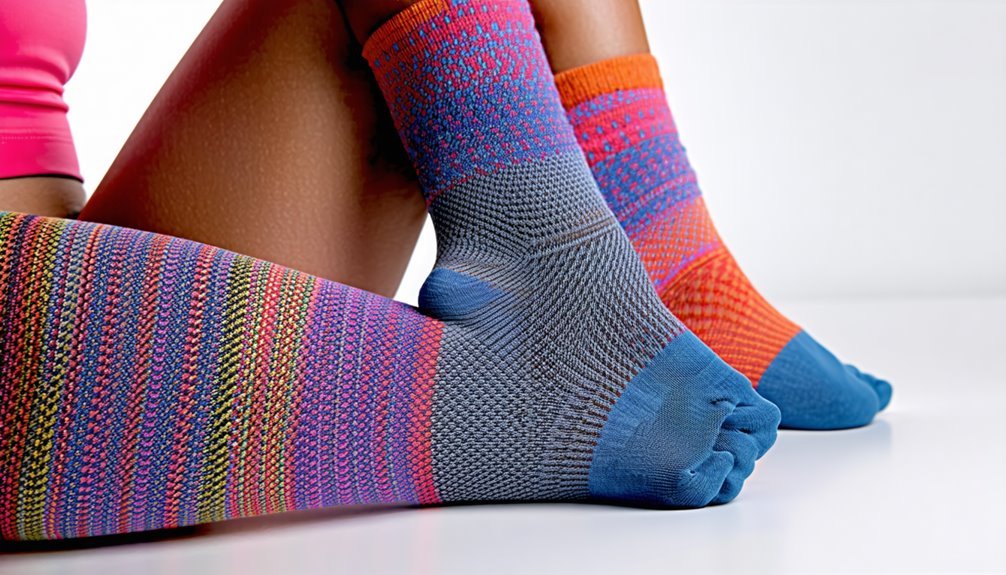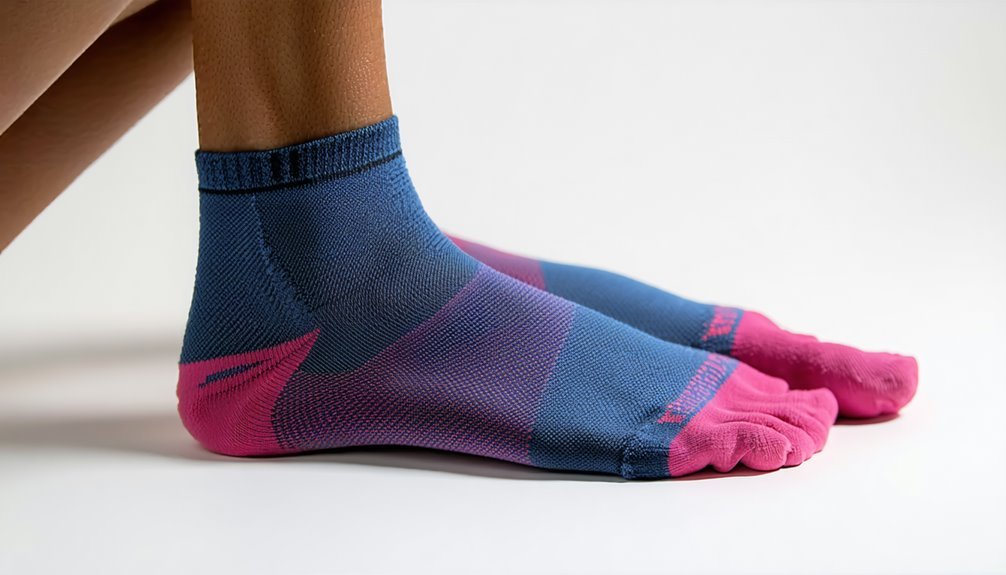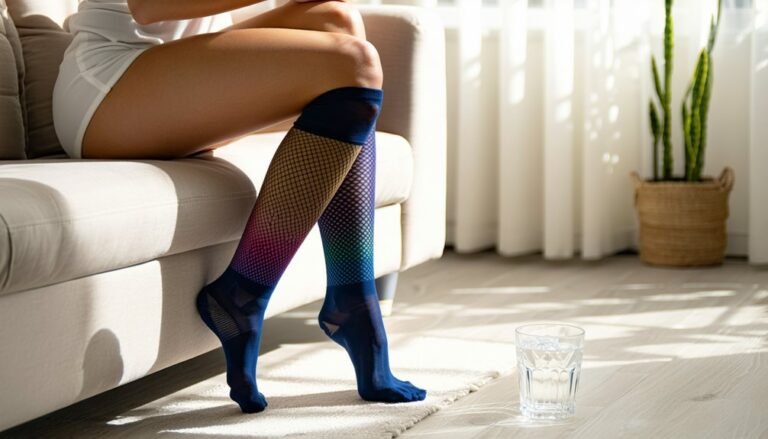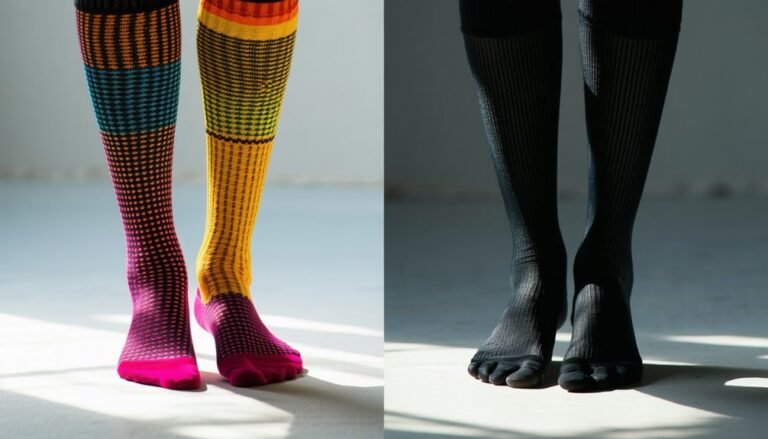Can Compression Socks Be Too Tight?
Compression socks can indeed be too tight, potentially leading to discomfort and circulation issues. Signs like persistent pain, red marks, or numbness indicate excessive tightness. Overly constrictive socks risk nerve damage and skin abrasions, while improperly restricted blood flow can worsen venous conditions. Accurate sizing, based on your exact measurements, guarantees effective compression. By understanding compression levels and proper fit, you'll maintain safety and comfort. Access more insights to confirm your compression therapy is ideal.
Understanding Compression Levels

When choosing compression socks, it's important to understand the different compression levels to secure you receive the therapeutic benefits tailored to your needs. Compression levels, measured in millimeters of mercury (mmHg), range from mild (8-15 mmHg) to extra firm (30-40 mmHg). Selecting the appropriate level is vital for effective venous return and reducing swelling. Low levels offer gentle support, while higher levels are often used for conditions like deep vein thrombosis.
Equally important is the sock material. Quality materials such as nylon and spandex guarantee the right elasticity and breathability, maximizing compression benefits while maintaining comfort and safety. Opt for options with moisture-wicking properties to prevent skin irritation. Remember, your choice should prioritize both the clinical effectiveness and your comfort.
How Compression Socks Work
Choosing the right compression level is just the beginning; understanding how compression socks function further empowers you to make informed decisions. Compression socks work by applying varying degrees of pressure to your legs, promoting blood circulation and reducing swelling. The pressure is usually strongest at the ankle and gradually decreases up the leg. This gradient compression technique assists in venous return, decreasing the risk of venous disorders.
Different compression sock types cater to specific needs, such as:
- Graduated compression: Ideal for everyday wear, enhancing circulation.
- Anti-embolism stockings: Used post-surgery to prevent blood clots.
- Non-medical support hosiery: Offers mild compression benefits for comfort.
Selecting the appropriate type and understanding the compression benefits guarantees you enjoy both comfort and therapeutic efficacy safely.
Signs Your Compression Socks Are Too Tight
If you experience discomfort or pain while wearing compression socks, it may indicate that they're too tight. Excessive tightness can impair venous circulation, leading to compromised blood flow and potential complications. It's essential to guarantee a proper fit to prevent these adverse effects and maintain ideal vascular health.
Discomfort and Pain
Many individuals may experience discomfort and pain as indicators that their compression socks are too tight. It's essential to understand the discomfort causes and seek pain relief to guarantee your well-being. When socks apply excessive pressure, it can lead to sensations that aren't just uncomfortable but potentially harmful. Be vigilant for symptoms like:
- Persistent aching or throbbing: This may suggest that the socks are compressing too harshly against your skin.
- Numbness or tingling: These sensations could indicate that the socks are obstructing nerve pathways.
- Red marks or indentations: Visible signs on your skin can reveal excessive pressure exerted by the socks.
If you experience any of these symptoms, consider adjusting the fit or consulting a healthcare professional for advice.
Restricted Blood Flow
While wearing compression socks can be beneficial, it's crucial to recognize signs of restricted blood flow that may indicate they're too tight. You might notice symptoms such as numbness, tingling, or cold extremities, which suggest impaired blood circulation. If these signs persist, it could compromise the effectiveness of your compression therapy. In severe cases, excessive tightness may lead to skin discoloration or swelling above or below the sock, indicating a blockage in blood flow.
Ensure your socks fit snugly but comfortably; they should enhance circulation, not hinder it. When applying compression therapy, always prioritize your safety. Regularly check for any discomfort or unusual sensations. If you suspect your socks are restricting circulation, consult a healthcare professional to reassess the appropriate compression level for your needs.
Health Risks of Overly Tight Compression Socks
Although compression socks are widely used for promoting circulation, wearing them too tightly can pose significant health risks. The pressure from overly tight socks can negate the compression sock benefits by impeding blood flow, potentially leading to numbness, tingling, or even skin damage. The sock material types, like nylon or spandex, can exacerbate these issues if not chosen correctly for your specific needs.
Consider the following risks:
- Nerve Damage: Excessive pressure can compress nerves, causing persistent discomfort or neuropathy.
- Skin Abrasions: Tight socks may lead to chafing or skin breakdown, increasing the risk of infections.
- Circulatory Issues: Impaired blood flow can exacerbate conditions like varicose veins or deep vein thrombosis.
Choose appropriately fitted socks to maintain safety and health.
Choosing the Right Compression Level

Selecting the appropriate compression level for socks is essential to maximize their therapeutic benefits while minimizing potential health risks. Understanding the various compression sock types and materials can guide you in making an informed choice. Compression levels are measured in millimeters of mercury (mmHg), indicating the pressure exerted on your legs. Light compression (8-15 mmHg) is generally suitable for everyday wear, while moderate (15-20 mmHg) and firm (20-30 mmHg) levels offer therapeutic effects for conditions like varicose veins or edema.
Consider the sock materials, too; breathable, moisture-wicking fabrics like nylon and spandex enhance comfort and efficacy. Consult with a healthcare professional to tailor the compression level to your specific needs, ensuring safety and effectiveness. Opt for high-quality socks to avoid compromising your health.
Measuring for the Perfect Fit
To achieve ideal therapeutic benefits from compression socks, obtaining the correct measurements is essential. Accurate measuring techniques guarantee the socks are not too tight, enhancing circulation and preventing potential complications. Use a flexible tape measure to assess the circumference of your calf and ankle. Compare your measurements with size charts provided by manufacturers to select the appropriate size. This provides a personalized fit tailored to your unique anatomical profile.
Accurate measurements ensure compression socks are not too tight, promoting circulation and preventing complications for a personalized fit.
- Calf Measurement: Measure the widest part to guarantee maximum compression.
- Ankle Measurement: Capture the narrowest point for accurate sizing.
- Size Chart Utilization: Align your measurements with the recommended size to prevent excessive tightness.
Tips for Wearing Compression Socks Comfortably
For ideal comfort while wearing compression socks, it's crucial to integrate them into your daily routine with care and attention. Choosing the right sock materials can make a significant difference in your comfort level. Opt for breathable, moisture-wicking fabrics to prevent skin irritation during daily wear. Always verify socks are applied evenly to avoid constriction. Here's a quick guide to help you:
| Tip | Description | Benefit |
|---|---|---|
| Morning Application | Wear in the morning when swelling is minimal | Enhances effectiveness |
| Proper Sizing | Follow precise measurements | Prevents excessive tightness |
| Material Selection | Choose breathable materials | Reduces moisture and odor |
| Gradual Adjustment | Gradually increase wear time | Encourages acclimation |
| Regular Inspection | Check for skin changes | Confirms safety |
Maintain this routine for peak circulation and comfort.
Common Misconceptions About Compression Socks
When it comes to compression socks, one common misconception is that one size fits all, but proper sizing is essential for their effectiveness and comfort. You might also hear myths about pressure levels, with some believing that tighter always means better, which isn't necessarily true and can even be harmful. Understanding these aspects guarantees you're using compression socks safely and effectively for your specific needs.
Proper Sizing Importance
Understanding the significance of proper sizing in compression socks is essential for both therapeutic efficacy and comfort. By adhering to the correct sizing guidelines, you can guarantee that the compression socks provide ideal circulatory support without compromising safety. Fit importance cannot be overstated, as improperly fitted socks may lead to discomfort or even exacerbate circulatory issues.
Consider the following when evaluating sizing:
- Anatomical Measurements: Accurately measure your ankle and calf circumferences to match the manufacturer's sizing chart.
- Fit Check: Verify the socks sit snugly without causing constriction or leaving indentations.
- Regular Reassessment: Periodically re-evaluate your measurements, as changes in health or weight may necessitate a new size.
Pressure Level Myths
Although compression socks are widely recommended for their circulatory benefits, misconceptions about pressure levels often lead to improper usage. You might believe that tighter means more effective, but this is one of the prevalent compression myths. Excessive pressure can constrict blood flow rather than facilitate it, counteracting the socks' intended purpose. It's essential to understand that compression socks are engineered with specific pressure gradients, measured in millimeters of mercury (mmHg), to safely enhance venous return.
Beware of pressure misconceptions that suggest higher pressure levels are universally beneficial. Medical-grade compression requires professional assessment to match individual needs. Too much pressure can risk skin damage or impair vascular function. Always consult healthcare professionals to determine the appropriate compression level for your condition, ensuring both safety and efficacy.
When to Consult a Healthcare Professional
If you're experiencing persistent discomfort or unusual symptoms while wearing compression socks, it's vital to consult a healthcare professional. Recognizing consultation signs early can prevent complications. Pay attention to symptoms such as skin discoloration, excessive swelling, or numbness. These may indicate your compression socks are too tight or not suitable for your condition. It's important to seek professional advice to guarantee your circulatory health is not compromised.
Consider consulting a healthcare professional if you notice:
- Persistent pain: Pain that doesn't subside could signify improper fit or underlying issues.
- Circulation changes: Tingling or cold extremities might indicate impaired blood flow.
- Worsening symptoms: If your symptoms escalate or new ones emerge, it's time for expert evaluation.
Your safety and well-being should always come first.
Frequently Asked Questions
Can Compression Socks Cause Skin Irritation or Allergic Reactions?
You might experience skin irritation or allergic reactions from compression socks due to skin sensitivity or allergic dermatitis. Verify you're using hypoallergenic materials and consult a healthcare professional if you notice persistent symptoms, prioritizing comfort and safety.
How Long Is It Safe to Wear Compression Socks Continuously?
It's coincidental you're asking about compression duration right now. Safety guidelines suggest wearing them for up to 12 hours. Prioritize comfort; remove them if discomfort arises. Always consult healthcare professionals to tailor recommendations to individual needs.
Are There Specific Brands Known for Better Comfort and Fit?
When you're looking into brand comparisons, consider comfort ratings and clinical effectiveness. Some brands prioritize patient safety with superior fit and material. Always choose those with high medical-grade standards to guarantee maximum comfort and support for your circulatory health.
Do Compression Socks Come in Different Styles and Colors?
Yes, compression socks come in various style variations and color options. When choosing, prioritize safety and comfort. Opt for clinically approved brands that offer a range of styles to guarantee therapeutic efficacy while meeting your personal aesthetic preferences.
Can Compression Socks Be Worn During Exercise or Sports Activities?
Sure, because who doesn't want to enhance their performance benefits and prevent injuries during exercise? Compression socks can be your best friend, offering clinical advantages like improved circulation and reduced muscle fatigue, ironically promoting safer workouts.







